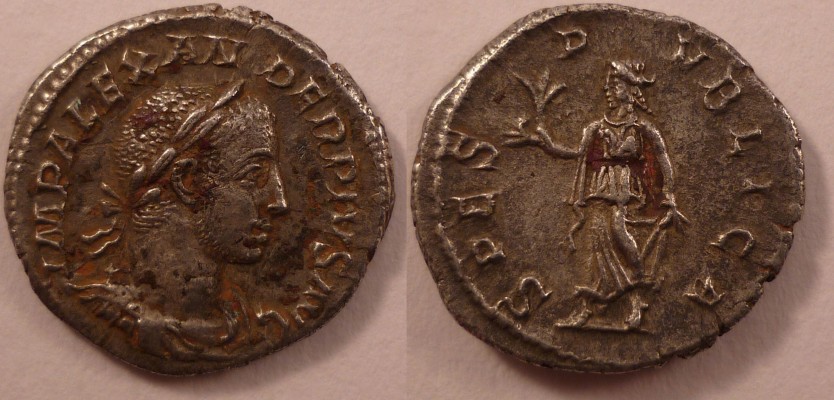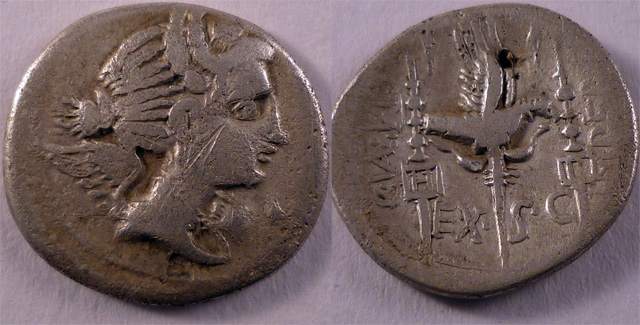During the Roman Republic there was no such tyhing as a hereditary office. In fact the Republic was all about the elections. They loved them. Every year the people would gather on the Campus Martius and vote for a range of offices, the highest of which was the Consulship. Each year two consuls would be elected and power would be shared between them, this meant that no man could hold absolute power.
This system was for the most part successful for some 450 years.
It was in 27BC Augustus declared to the senate that he wished to resign from his position as perpetual consul in order to enjoy a more private life. The senate was having none of it though. They refused to accept his resignation and instead asked him to remain as head of the Republic, giving him the titles "Augustus", "princeps", "pater patriae" and "imperator".
As we all know he accepted these honours but all these titles are literally just that. No powers came directly attached; the senate had to instead attach powers to the office. The gave the princeps:
1) Tribunicians power or "tribunicia potestas". This is often recorded on the coins of various emperors, such as this denarius of Vespasian

Vespasian Denarius. 70-72 AD.
Obverse: IMP CAES VESP AVG PM laureate head right
Reverse: TRI POT Vesta seated left holding simpulum
RIC II 37 3.23g 18mm
Obverse: IMP CAES VESP AVG PM laureate head right
Reverse: TRI POT Vesta seated left holding simpulum
RIC II 37 3.23g 18mm
This power gave the princeps the right, call a meeting of the Senate, to involve himself in almost any legal matter and to veto motions in the Senate. .
2) Proconsular Power "imperium proconsulare maius"
The power gave Augustus imperium over several provinces, allowing him to command the armies within. While initially this was only a few provinces most of Rome's legions were contained within these provinces; effectively giving Augustus power over Roman military. Over time this power obviously extended so that the Emperor was supreme commander of all of Rome's military.
3) The head of state religion "Pontifex maximus"
This allowed the princeps to ensure that auguries were always favorable and that the right ideals were being promoted by the state religion. This was often portrayed on coins a "PM", "PON M" or "PON MAX", as seen on these coins of Septimius Severus, Claudius and Vespasian.
2) Proconsular Power "imperium proconsulare maius"
The power gave Augustus imperium over several provinces, allowing him to command the armies within. While initially this was only a few provinces most of Rome's legions were contained within these provinces; effectively giving Augustus power over Roman military. Over time this power obviously extended so that the Emperor was supreme commander of all of Rome's military.
3) The head of state religion "Pontifex maximus"
This allowed the princeps to ensure that auguries were always favorable and that the right ideals were being promoted by the state religion. This was often portrayed on coins a "PM", "PON M" or "PON MAX", as seen on these coins of Septimius Severus, Claudius and Vespasian.

Septimius Severus, Silver Denarius, Rome Mint, 195 AD
Obverse: L SEPT SEV PERT AVG IMP V, laureate head right
Reverse: P M TR P III COS II P P, Mars advancing right with trophy over shoulder & spear
RIC 60, 3.12g, 18mm
Obverse: L SEPT SEV PERT AVG IMP V, laureate head right
Reverse: P M TR P III COS II P P, Mars advancing right with trophy over shoulder & spear
RIC 60, 3.12g, 18mm
See on the reverse the continuation of Severus' title includes "P(ontifex) M(aximus)

Claudius Quadrans 41AD
Obv: "TI CLAVDIVS CAESAR AVG" around modius
Rev: "PON M TR P IMP COS DES IT" around large SC
RIC 84, 2.18g, 16-18mm

Vespasian Denarius. 69-79AD.
Obverse: IMP CAESAR VESPASIANVS AVG laureate head right
Reverse: PON MAX TR P COS V Vespasian seated right with branch & scepter
RIC II 77, 3.13g, 18mm
Obv: "TI CLAVDIVS CAESAR AVG" around modius
Rev: "PON M TR P IMP COS DES IT" around large SC
RIC 84, 2.18g, 16-18mm
On this quadrans of Claudius we can (or would be able to if the photo wasn't so poor) again see "POM M"
Finally we have this example of Vespasian
Finally we have this example of Vespasian

Vespasian Denarius. 69-79AD.
Obverse: IMP CAESAR VESPASIANVS AVG laureate head right
Reverse: PON MAX TR P COS V Vespasian seated right with branch & scepter
RIC II 77, 3.13g, 18mm
Now even with all these powers Augustus wasn't happy. He assumed a few extra powers to boot including; managing the treasury (Aerarium) and censor. This gave him power over the money supply as well as the justice system.
This basically leaves us with a senate for show as one man now controls all of the Empires vital organs. The money, the law, the religion, the justice and (possibly the most important) the military. I will look at the military in depth in a few days but first I will look at the idea of dynasty tomorrow.

I will leave you with a couple pieces from my collection;
A Spes denarius I have fallen in love with. It may not be the finest example but it has real character and wonderful tones.
A Spes denarius I have fallen in love with. It may not be the finest example but it has real character and wonderful tones.

AR Denarius, Severus Alexander (222 – 235 AD) Rome 231 - 235 AD.
Obv.: IMP ALEXANDER PIVS AVG; draped and laureate bust of emperor right.
Rev.: SPES PVBLICA; Spes walking left, holding branch in right hand, lifting skirt with right hand.
RIC 254, 19 mm. 2.89 g.
Obv.: IMP ALEXANDER PIVS AVG; draped and laureate bust of emperor right.
Rev.: SPES PVBLICA; Spes walking left, holding branch in right hand, lifting skirt with right hand.
RIC 254, 19 mm. 2.89 g.
Also my new favourite piece a lovely Republican denarius C. Valerius Flaccus. I have spent a lot of time reading up on the legionary denarii of Septimius Severus and in one excellent article I saw a reference to this earlier denarius with a similar reverse and when I saw it I had to have one. The photo really does not do this coin justice with the wonderful high relief of the legionary eagle anyway....

Ar Denarius of C. Valerius Flaccus 82-81BC
Obverse: Bust of Victory Right, Symbol in front of head.
Reverse: "C.VAL.FLA.IMPERAT" Legionary eagle between two standards inscribed H and P, EX S.C between them.
3.49g, 19mm, RSC Valeria 12a

Ar Denarius of C. Valerius Flaccus 82-81BC
Obverse: Bust of Victory Right, Symbol in front of head.
Reverse: "C.VAL.FLA.IMPERAT" Legionary eagle between two standards inscribed H and P, EX S.C between them.
3.49g, 19mm, RSC Valeria 12a
Vale habeque somnia suaves!
This was in fact the best system if thought upon. Divided power meant just rule by the two consuls. I think it should be implemented around the world for better system.
ReplyDeleteThis comment has been removed by the author.
ReplyDelete